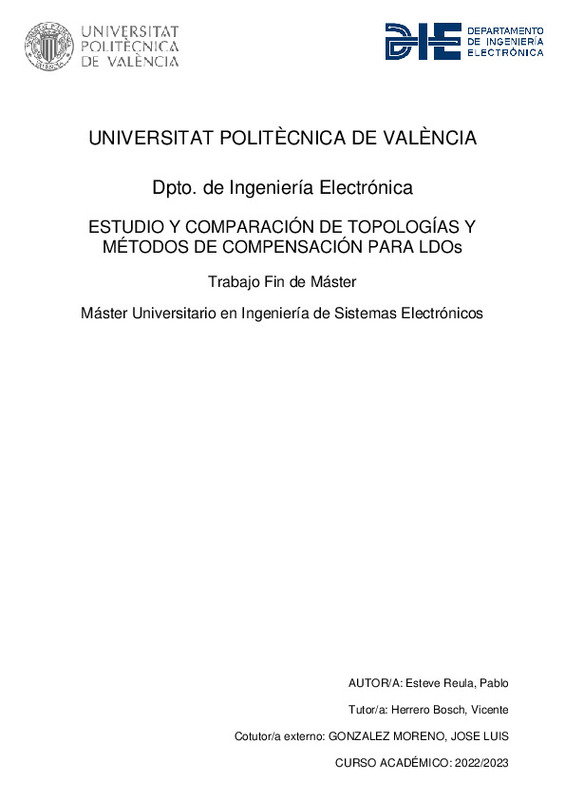JavaScript is disabled for your browser. Some features of this site may not work without it.
Buscar en RiuNet
Listar
Mi cuenta
Estadísticas
Ayuda RiuNet
Admin. UPV
ESTUDIO Y COMPARACIÓN DE TOPOLOGÍAS Y MÉTODOS DE COMPENSACIÓN PARA LDOs
Mostrar el registro sencillo del ítem
Ficheros en el ítem
| dc.contributor.advisor | Herrero Bosch, Vicente
|
es_ES |
| dc.contributor.author | Esteve Reula, Pablo
|
es_ES |
| dc.date.accessioned | 2023-07-26T14:26:47Z | |
| dc.date.available | 2023-07-26T14:26:47Z | |
| dc.date.created | 2023-07-18 | es_ES |
| dc.date.issued | 2023-07-26 | es_ES |
| dc.identifier.uri | http://hdl.handle.net/10251/195528 | |
| dc.description.abstract | [ES] Este trabajo es un estudio comparativo entre diferentes arquitecturas de LDOs (Low Dropout Regulators) y varios métodos de compensación que se pueden aplicar durante su diseño. Para ello se empezará analizando cuáles son las especificaciones principales que afectan a un circuito de estas características y cómo cada uno de los componentes que forman parte del lazo modifican las prestaciones. Después se continuará con los diseños propiamente dichos, donde primero se distinguirá entre el tipo de transistor de paso nMOS o pMOS, se estudiará su efecto en la respuesta del lazo y la PSRR (Power Supply Rejection Ratio), y se dimensionará acorde a las especificaciones propuestas, y segundo se propondrán varias soluciones sobre las que se aplicarán las distintas arquitecturas de amplificador de error y redes de realimentación, y los métodos de compensación con la capacidad de Miller, la capacidad paralela, y el uso de buffers. Estas soluciones estarán enfocadas principalmente a la obtención de la estabilidad y la PSRR, donde se analizarán los límites de cada propiedad, a que se deben, y se simularán las mejores para generar un punto de comparación entre ellas. Los resultados de este estudio muestran una mejor respuesta de la PSRR en transistores de paso tipo nMOS frente a los pMOS debido a su mayor impedancia vista desde la fuente de alimentación, aunque el inconveniente de esta elección es el de tener que emplear siempre una fuente de alimentación adicional y superior a la primera para alimentar la etapa anterior. La aplicación de los métodos de compensación y la variante del amplificador de error elegida también se revelan fundamentales para el correcto control de la respuesta en frecuencia del lazo y obtener la mejor PSRR posible en los diseños más restrictivos. | es_ES |
| dc.description.abstract | [EN] This thesis is a comparative study between different LDO (Low Dropout Regulators) architectures and various compensation methods that can be applied during their design. It will start by analyzing which are the main specifications points that affect a circuit of these characteristics and how each of the components that are part of the loop modify the performance. Then it will continue with the actual designs, where it will first distinguish between the nMOS or pMOS type pass transistor, study its effect on the loop response and the PSRR (Power Supply Rejection Ratio), and size it according to the proposed specifications, and secondly it will propose several solutions on which the different architectures of error amplifiers and feedback networks, and compensation methods with Miller capacitance, parallel capacitance, and the use of buffers will be applied. These solutions will be mainly focused on obtaining stability and PSRR, finding where the limits of each property are and what they are due to, and simulating the best ones to generate a common point of comparison between them. The results of this study show a better response of the PSRR in nMOS type pass transistors versus pMOS due to their higher impedance seen from the power supply, although the drawback of this choice is always having to use an additional and higher voltage power supply than the first one to feed the previous stage. The application of the compensation methods and the chosen error amplifier variant also prove to be essential for the correct control of the loop frequency response and to obtain the best possible PSRR in the most restrictive designs. | en_EN |
| dc.format.extent | 154 | es_ES |
| dc.language | Español | es_ES |
| dc.publisher | Universitat Politècnica de València | es_ES |
| dc.rights | Reconocimiento (by) | es_ES |
| dc.subject | LDO | es_ES |
| dc.subject | Compensación | es_ES |
| dc.subject | PSRR | es_ES |
| dc.subject | Compensation | en_EN |
| dc.subject.classification | TECNOLOGIA ELECTRONICA | es_ES |
| dc.subject.other | Máster Universitario en Ingeniería de Sistemas Electrónicos-Màster Universitari en Enginyeria de Sistemes Electrònics | es_ES |
| dc.title | ESTUDIO Y COMPARACIÓN DE TOPOLOGÍAS Y MÉTODOS DE COMPENSACIÓN PARA LDOs | es_ES |
| dc.title.alternative | STUDY AND COMPARISON OF TOPOLOGIES AND COMPENSATION METHODS FOR LDOs | es_ES |
| dc.title.alternative | ESTUDI I COMPARACIÓ DE TOPOLOGIES I MÈTODES DE COMPENSACIÓ PER A LDOs | es_ES |
| dc.type | Tesis de máster | es_ES |
| dc.rights.accessRights | Abierto | es_ES |
| dc.contributor.affiliation | Universitat Politècnica de València. Departamento de Ingeniería Electrónica - Departament d'Enginyeria Electrònica | es_ES |
| dc.contributor.affiliation | Universitat Politècnica de València. Escuela Técnica Superior de Ingenieros de Telecomunicación - Escola Tècnica Superior d'Enginyers de Telecomunicació | es_ES |
| dc.description.bibliographicCitation | Esteve Reula, P. (2023). ESTUDIO Y COMPARACIÓN DE TOPOLOGÍAS Y MÉTODOS DE COMPENSACIÓN PARA LDOs. Universitat Politècnica de València. http://hdl.handle.net/10251/195528 | es_ES |
| dc.description.accrualMethod | TFGM | es_ES |
| dc.relation.pasarela | TFGM\156106 | es_ES |
Este ítem aparece en la(s) siguiente(s) colección(ones)
-
ETSIT - Trabajos académicos [2148]
Escuela Técnica Superior de Ingenieros de Telecomunicación






